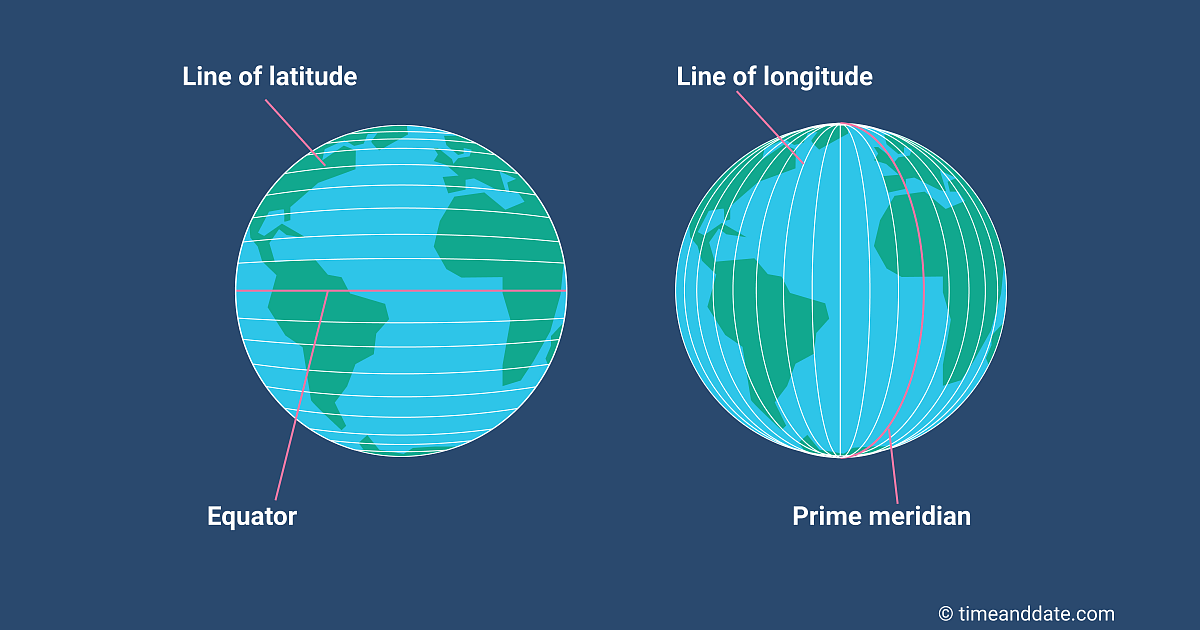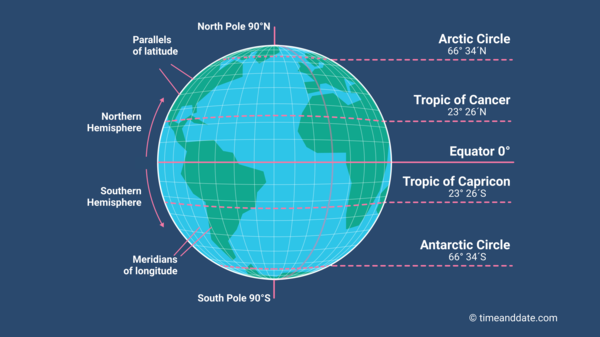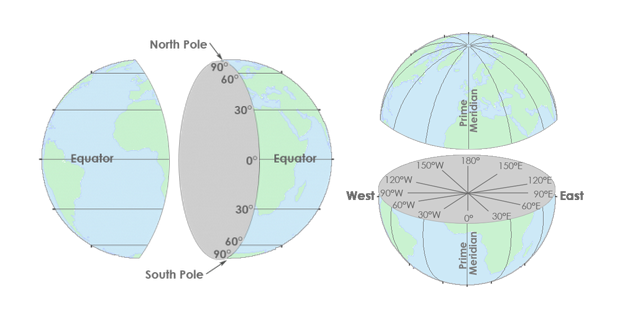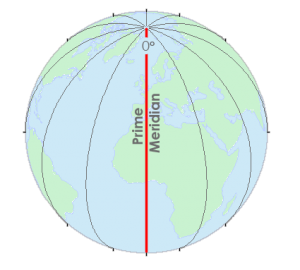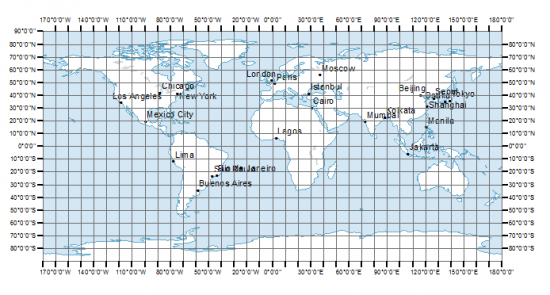что такое latitude и longitude
longitude and latitude
Смотреть что такое «longitude and latitude» в других словарях:
latitude — lat‧i‧tude [ˈlættjuːd ǁ tuːd] noun [uncountable] JOURNALISM freedom to choose what you do or say: latitude in • The new guidelines give banks more latitude in making loans. • States generally have wide latitude in setting tax policies. * * *… … Financial and business terms
Longitude — For Dava Sobel s book about John Harrison, see Longitude (book). For the adaptation of Sobel s book, see Longitude (TV series). Map of Earth Longitude (λ) Lines of longitude appear vertical with varying curvature in this projection, but are… … Wikipedia
Latitude — This article is about the geographical reference system. For other uses, see Latitude (disambiguation). Map of Earth Longitude (λ) Lines of longitude appear vertical with varying curvature in this projection, but are actually halves of great… … Wikipedia
latitude and longitude — Coordinate system by which the position or location of any place on the Earth s surface can be determined and described. Latitude is a measurement of location north or south of the Equator. Lines of latitude are known as parallels, or parallels… … Universalium
longitude — [län′jə to͞od΄, län′jətyo͞od΄; lôn′jə to͞od΄, lôn′jə tyo͞od΄] n. [ME < L longitudo < longus, LONG1] 1. length 2. distance east or west on the earth s surface, measured as an arc of the equator (in degrees up to 180° or by the difference in… … English World dictionary
Longitude prize — The Longitude Prize was a reward offered by the British government through an Act of Parliament in 1714 for a simple and practical method for the precise determination of a ship s longitude. The prize was administered by the Board of… … Wikipedia
Latitude and longitude of cities — See:*Latitude and longitude of cities, A H *Latitude and longitude of cities, I P *Latitude and longitude of cities, Q Z … Wikipedia
Latitude and longitude of cities, A-H — ee also*Latitude and longitude of cities, I P *Latitude and longitude of cities, Q Z … Wikipedia
Latitude and longitude of cities, I-P — ee also*Latitude and longitude of cities, A H *Latitude and longitude of cities, Q Z … Wikipedia
Latitude and longitude of cities, Q-Z — ee also*Latitude and longitude of cities, A H *Latitude and longitude of cities, I P … Wikipedia
latitude longitude
1 latitude/longitude
2 указатель широты и долготы
См. также в других словарях:
latitude and longitude — Coordinate system by which the position or location of any place on the Earth s surface can be determined and described. Latitude is a measurement of location north or south of the Equator. Lines of latitude are known as parallels, or parallels… … Universalium
latitude — Heliocentric He li*o*cen tric (h[=e] l[i^]*[ o]*s[e^]n tr[i^]k), Heliocentrical He li*o*cen tric al (h[=e] l[i^]*[ o]*s[e^]n tr[i^]*kal), a. [Helio + centric, centrical: cf. F. h[ e]liocentrique.] (Astron.) pertaining to the sun s center, or… … The Collaborative International Dictionary of English
longitude — Heliocentric He li*o*cen tric (h[=e] l[i^]*[ o]*s[e^]n tr[i^]k), Heliocentrical He li*o*cen tric al (h[=e] l[i^]*[ o]*s[e^]n tr[i^]*kal), a. [Helio + centric, centrical: cf. F. h[ e]liocentrique.] (Astron.) pertaining to the sun s center, or… … The Collaborative International Dictionary of English
longitude — Refraction Re*frac tion (r?*fr?k sh?n), n. [F. r[ e]fraction.] 1. The act of refracting, or the state of being refracted. [1913 Webster] 2. The change in the direction of ray of light, heat, or the like, when it enters obliquely a medium of a… … The Collaborative International Dictionary of English
longitude — [ lɔ̃ʒityd ] n. f. • 1525; « longueur » 1314; lat. longitudo ♦ L une des coordonnées sphériques d un point de la surface terrestre; distance angulaire de ce point au méridien d origine mesurée en degrés. Île située par 60° de latitude sud et 40°… … Encyclopédie Universelle
latitude — [ latityd ] n. f. • 1314; lat. latitudo « largeur » I ♦ 1 ♦ Vx Largeur. Spécialt Large acception ou extension. 2 ♦ (XVIe) Fig. Faculté, pouvoir d agir (en toute liberté). Mod. Donner, laisser toute latitude à qqn pour faire qqch. ⇒ … Encyclopédie Universelle
latitude — lat‧i‧tude [ˈlættjuːd ǁ tuːd] noun [uncountable] JOURNALISM freedom to choose what you do or say: latitude in • The new guidelines give banks more latitude in making loans. • States generally have wide latitude in setting tax policies. * * *… … Financial and business terms
Latitude Galactique — En astronomie, la latitude galactique est la coordonnée de type latitude permettant de situer les objets sur la sphère céleste dans un système de coordonnées où l équateur serait déterminé par le plan galactique et où l origine des longitudes… … Wikipédia en Français
Longitude Galactique — En astronomie, la longitude galactique est la coordonnée de type longitude permettant de repérer les objets sur la sphère céleste dans un système de coordonnées où l équateur serait déterminé par le plan galactique et où l origine des longitudes… … Wikipédia en Français
latitude — [lat′ə to͞od΄, lat′ətyo͞od΄] n. [OFr < L latitudo < latus, wide: see LATERAL] 1. Rare breadth; width 2. Rare extent; scope; range of applicability 3. freedom from narrow restrictions; freedom of opinion, conduct, or action 4. see… … English World dictionary
What are the lengths of Location Coordinates, latitude and longitude? [closed]
Want to improve this question? Add details and clarify the problem by editing this post.
How many digits can latitude and longitude have, before the decimal, and after the decimal?
Here is an example I am getting from the location sent by a Windows Phone device:
This is very long and is exceeding my table column size and causes errors.
7 Answers 7
Overview
The Prime Meridian has a longitude of 0° that goes through Greenwich, England. The International Date Line (IDL) roughly follows the 180° longitude. A longitude with a positive value falls in the eastern hemisphere and the negative value falls in the western hemisphere.
Decimal degrees precision
For millimeter (mm) precision then represent lat/lon with 8 decimal places in decimal degrees format. Since most applications don’t need that level of precision 6 decimal places is sufficient for most cases.
In the other direction, whole decimal degrees represent a distance of
111 km (or 60 nautical miles) and a 0.1 decimal degree difference represents a
Here is a table of # decimal places difference in latitude with the delta degrees and the estimated distance in meters using 0,0 as the starting point.
| Decimal places | Decimal degrees | Distance (meters) | |
|---|---|---|---|
| 0 | 1.0 | 110,574.3 | 111 km |
| 1 | 0.1 | 11,057.43 | 11 km |
| 2 | 0.01 | 1,105.74 | 1 km |
| 3 | 0.001 | 110.57 | |
| 4 | 0.0001 | 11.06 | |
| 5 | 0.00001 | 1.11 | |
| 6 | 0.000001 | 0.11 | 11 cm |
| 7 | 0.0000001 | 0.01 | 1 cm |
| 8 | 0.00000001 | 0.001 | 1 mm |
Degrees-minute-second (DMS) representation
For DMS notation 1 arc second = 1/60/60 degree =
30 meter length and 0.1 arc sec delta is
1 arc minute = 1/60 degree =
Update:
Here is an amusing comic strip about coordinate precision.
What Are Longitudes and Latitudes?
Cartographers and geographers trace horizontal and vertical lines called latitudes and longitudes across Earth’s surface to locate points on the globe.
Longitudes and latitudes.
Together, they form the Earth’s geographical coordinates, and represent the angular distance of any location from the center of the Earth. Both latitudes and longitudes are measured in degrees (°) and minutes (′).
Dividing Earth Into Hemispheres
The Earth is, almost, but not quite, a sphere that rotates around its axis. Scientists call this shape a spheroid or ellipsoid. If we draw a line passing through the center of the Earth along its rotational axis, the line would pass through the North and the South Pole.
The Equator is an imaginary line perpendicular to this axis. It is equidistant from the North and South Poles, and divides the globe into the Northern Hemisphere and the Southern Hemisphere.
Most locations on the Equator experience consistently high temperatures throughout the year. They also experience at least 12 hours of daylight every day during the year. On the Equinoxes – September and March – the Sun is directly overhead the Equator, resulting in almost exactly 12 hour days and 12 hour nights.
The Equator passes through 14 countries, including Uganda, Kenya, Somalia, Indonesia, Ecuador, Colombia, and Brazil.
Imaginary Circles
Often called parallels or circles of latitude, latitudes are imaginary circles parallel to the Equator. They are named after the angle created by a line connecting the latitude and the center of the Earth, and the line connecting the Equator and the center of the Earth.
Latitudes specify the north-south position of a location on the globe. Locations in the Northern Hemisphere are identified by northern latitudes and are assigned a suffix of N for north. Southern Hemisphere locations, on the other hand, are on southern latitudes and are assigned a suffix of S for south.
Notable Latitudes
The major latitudes and longitudes.
The Equator represents 0° latitude, while the North and South Poles represent 90° North and 90° South latitudes. In addition to the Equator, there are four other major latitudes that are usually found on maps and globes. The positions of these latitudes are determined by the Earth’s axial tilt.
The latitude 23° 26′ North is also known as the Tropic of Cancer. It marks the northern-most position on the Earth, where the Sun is directly overhead at least once a year. This happens during the June Solstice, when the Earth’s Northern Hemisphere is tilted towards the Sun.
The Tropic of Capricorn is the latitude that lies at 23° 26′ South of the Equator. It is the southern-most position on the globe, where the Sun is directly overhead during the December Solstice.
Sometimes, latitudes north of the Equator are denoted by a positive sign. Latitudes south of the Equator are given negative values. This eliminates the need to add whether the specified latitude is north or south of the Equator.
East-West Locations
Longitudes are geographical positioning markers that run from the geographical North Pole to the geographical South Pole, intersecting the Equator. They meet at both Poles, and specify the east-west position of a location.
Longitudes are, therefore, imaginary circles that intersect the North and South Poles and the Equator. Half of a longitudinal circle is known as a Meridian. Meridians are perpendicular to every latitude.
Unlike, latitudes, there is no obvious central longitude. However, in order to measure the position of a location based on the longitude, cartographers and geographers over the course of history have designated different locations as the main longitudinal reference point. Today, the meridian line through Greenwich, England, is considered as the reference point for longitudes. This line is also known as the Prime Meridian.
The Prime Meridian is set as 0° longitude and it divides the Earth into the Eastern and the Western Hemispheres. All the other longitudes are measured and named after the angle they make with respect to the center of the Earth from the intersection of the Meridian and the Equator.
Since a sphere has 360 degrees, the Earth is divided into 360 longitudes. The meridian opposite the Prime Meridian (on the other side of the Earth) is the 180° longitude and is known as the antimeridian.
Modern timekeeping systems use longitudes as references to keep time. Time zones are defined by the Prime Meridian and the longitudes.
An Easy Way to Remember
One easy way to remember the orientation of latitudes and longitudes is longitudes are long, and latitudes are lateral.
Did You Know?
A Great Circle is any circle that is formed by a plane that passes through the center of the Earth. The Equator and the circles created by the meridians form Great Circles.
The shortest line between two points on the Earth’s surface is always the arc of a Great Circle. Because of this, Great Circles are important for the study of migration and other human interactions and activities, including shipping and airline routes.
Latitude, Longitude and Coordinate System Grids
Latitude, Longitude and Coordinate System Grids
Here’s how you can remember latitude and longitude:
Latitude and longitude coordinates make up our geographic coordinate system.
Map Coordinate Systems
You can give any location on Earth latitude and longitude coordinates.
The field of study that measures the shape and size of the Earth is geodesy. Geodesists use coordinate reference systems such as WGS84, NAD27 and NAD83. In each coordinate system, geodists use mathematics to give each position on Earth a unique coordinate.
A geographic coordinate system defines two-dimensional coordinates based on the Earth’s surface. It has an angular unit of measure, prime meridian and datum (which contains the spheroid).
The equator is where we measure north and south. For example, everything north of the equator has positive latitude values. Whereas, everything south of the equator has negative latitude values.
The Greenwich Meridian (or prime meridian) is a zero line of longitude from which we measure east and west. In fact, the zero line passes through the Royal Observatory in Greenwich, England, which is why we call it what it is today. In a geographical coordinate system, the prime meridian is the line that has 0° longitude.
Most horizontal datums assign the equator as a zero line of latitude. The equator is where we measure north and south. Whereas, the Greenwich Meridian (or prime meridian) is a zero line of longitude from which we measure east and west.
Together, these lines provide a reference for latitude and longitude that always zig-zag into each other. This geographic grid gives unique latitude and longitude for every position on Earth.
Find Anything on Earth with Coordinates
Coordinates are pairs (X, Y) in a two-dimensional space referenced to a horizontal datum. Whereas triplets (X, Y, Z) of points not only has a position but also has height referenced to a vertical datum. In other words, the X- and Y-values represent a horizontal position. Whereas, the Z-value represents the vertical position.
Geographic coordinate systems use an ellipsoid to approximate all locations on the surface of the earth. Whereas, the datum defines the surface.
A horizontal datum has a major axis, which is the longest diameter of an ellipse. Also, it has a minor axis, which is the shortest diameter of an ellipse. Finally, a horizontal datum has a radius that represents the position of the surface relative to the center of the earth.
Additionally, time zones roughly use lines of longitude at 15° intervals. Starting at the Prime Meridian, there are 24 different time zones in the world, as shown in the world time zone map.
What is a Coordinate Reference System?
A reference ellipsoid is the mathematical model of the shape of the Earth with the major axis along the equatorial radius. A geographic coordinate system uses longitude and latitude expressed in decimal degrees. For example, WGS 1984 and NAD 1983 are the most common datums today. Before 1983, NAD27 was the most common datum.
Cartographers write spherical coordinates (latitudes and longitudes) in degrees-minutes-seconds (DMS) and decimal degrees. For degrees-minutes-seconds, minutes range from 0 to 60. For example, the geographic coordinate expressed in degrees-minutes-seconds for New York City is:
You can also express geographic coordinates in decimal degrees. It’s just another way to represent that same location in a different format. For example, here is New York City in decimal degrees:
The Federal Communications Commission has a DMS-Decimal converter tool that converts latitude and longitude between decimal degrees and degrees, minutes, and seconds.
Latitude, Longitude and Spherical Coordinate System Grids
When you put two coordinates together as a pair (X, Y), you can locate anything on Earth.
Latitude and longitude form our coordinate system grid.
Also, you can express coordinates in different ways. For example, you can use decimal degrees or degrees-minutes-seconds.
Thanks to our geographic coordinate, you can pinpoint any point on Earth such as GPS receivers. And this includes the spot you are reading this article right now.


